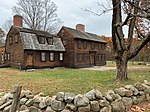Hoar Tavern
1680 establishments in the Massachusetts Bay ColonyBuildings and structures completed in 1680Drinking establishments on the National Register of Historic Places in MassachusettsHouses in Lincoln, MassachusettsNational Register of Historic Places in Middlesex County, Massachusetts ... and 1 more
Taverns in Massachusetts

Hoar Tavern, or the Hoar Homestead, is a historic tavern and house northeast of downtown Lincoln on Reiling Pond Road in Lincoln, Massachusetts. With a construction history dating to 1680, it was for nearly two centuries home to the Hoar family, a prominent legal and political family in Massachusetts. It was listed on the National Register of Historic Places in 1973.
Excerpt from the Wikipedia article Hoar Tavern (License: CC BY-SA 3.0, Authors, Images).Hoar Tavern
Reiling Pond Road,
Geographical coordinates (GPS) Address Nearby Places Show on map
Geographical coordinates (GPS)
| Latitude | Longitude |
|---|---|
| N 42.435555555556 ° | E -71.276638888889 ° |
Address
Reiling Pond Road 10
01731
Massachusetts, United States
Open on Google Maps






